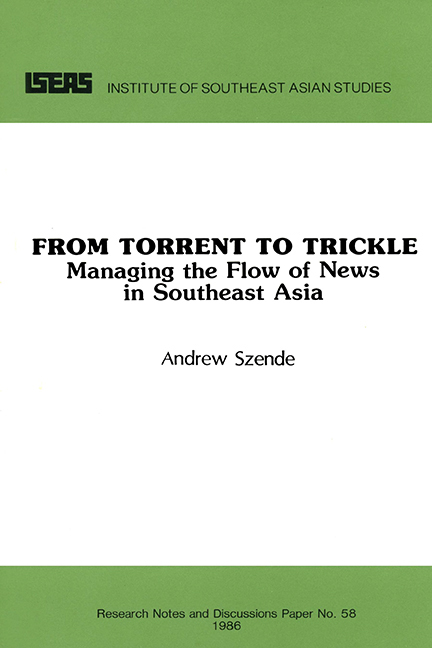Book contents
- Frontmatter
- Contents
- LIST OF TABLES
- Acknowledgements
- PART 1 INTRODUCTION
- PART 2 PERCEPTIONS
- IV The Dilemma of the ASEAN Exchange
- V News Samples in ASEAN
- VI Perceptions of Coverage in ASEAN
- VII Regional Coverage in ASEAN
- PART 3 CONCLUSION
- APPENDIX A
- APPENDIX B
- APPENDIX C
- APPENDIX D
- APPENDIX E
- APPENDIX F
- BIBLIOGRAPHY
- THE AUTHOR
V - News Samples in ASEAN
from PART 2 - PERCEPTIONS
Published online by Cambridge University Press: 21 October 2015
- Frontmatter
- Contents
- LIST OF TABLES
- Acknowledgements
- PART 1 INTRODUCTION
- PART 2 PERCEPTIONS
- IV The Dilemma of the ASEAN Exchange
- V News Samples in ASEAN
- VI Perceptions of Coverage in ASEAN
- VII Regional Coverage in ASEAN
- PART 3 CONCLUSION
- APPENDIX A
- APPENDIX B
- APPENDIX C
- APPENDIX D
- APPENDIX E
- APPENDIX F
- BIBLIOGRAPHY
- THE AUTHOR
Summary
In this chapter, the flow of news is examined through a comparison of stories that are used by the editors in their newspapers and news agencies. This evidence is drawn from the ASEAN coverage provided by five news agencies and five newspapers during what may be considered three average news days in March 1983, on which no extraordinary event dominated the news. This evidence is supplemented by a second comparison of the ASEAN coverage provided by the same five newspapers during what may be considered three extraordinary news days for the region in June 1983, on which the annual ASEAN ministerial meetings took place in Bangkok. These comparisons do not represent a content analysis of the papers concerned. They were intended merely to show what sources and categories of news are used by the editors in their coverage of the region, what sort of pattern exists in the flow of news within the region and what kinds of stories seem to have regional appeal. These questions are considered in relation to the expressed perceptions of the ASEAN news professionals, which were elicited in personal interviews. An examination of the content of these stories, while potentially useful and unquestionably interesting, was outside the scope ot this study.
Respondents to this study were quite critical of the way ASEAN news is presented to the world, particularly by the international agencies. Many of them argued that the western agencies do not present a balanced view of ASEAN countries, but run a preponderance of critical, negative stories, using western biases. The majority felt that while in five categories the coverage was more or less adequate, in seven other categories it was rather inadequate. In spite of this criticism, the ASEAN news professionals indicated in interviews that they use international news agencies as their first and foremost sources of news for covering ASEAN. Now, a comparison of the categories of stories offered by two of the smaller international news agencies during two average news days yields some supporting evidence for these perceptions.
- Type
- Chapter
- Information
- From Torrent to TrickleManaging the Flow of News in Southeast Asia, pp. 53 - 66Publisher: ISEAS–Yusof Ishak InstitutePrint publication year: 1986

